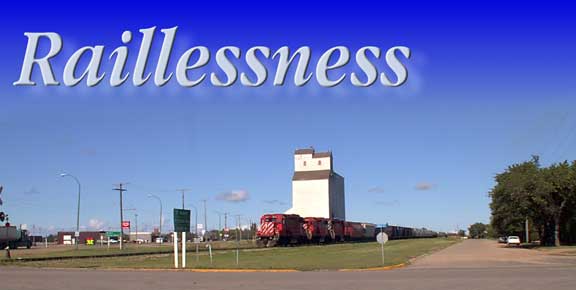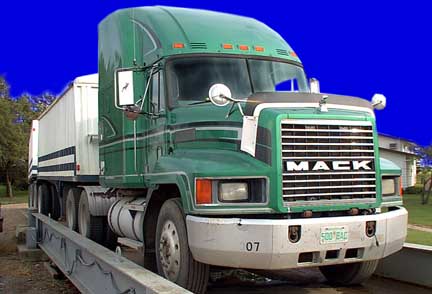 |
| FTLComm - Weekes - August 3, 2000 |
| It is easy enough talking about the abstract ramifications of the closure of rural
elevators and the abandonment of branch rail lines. We can conjecture upon the harsh
realities of increased farm cost to deliver their produce and the resulting damage
to the road system, we can even speculate about what sort of affect this has on the
way of life but all of that is just talk until you get a first hand look at the problem
and see just what affects that has on the land, the farmers involved and the public
in general as ultimately we all share in the economical and social discomforts of
our land. The map below might help you to focus on the way default decisions are made. The way things often work is a decision is made and it has direct and indirect ramifications some of which are remarkably profound and sort of go along as natural consequences of making the initial decision. CN had operated a line from Crooked River to Bjorkdale, Chelan, Porcupine Plain, Carrigana, Somme, Weekes and Reserve. Only twenty-five years ago this line had passenger service. The green line on the map indicate the CN line that goes East from Tisdale to Crooked River and then goes to Peesane, Mistatim, Prairie River and on to Hudson Bay. This line is indicated as a solid green line with a thin black line on it, while the line that had passed through Porcupine Plain is shown here as a dotted line as it has been removed. The rails have been taken up but the right of way remains the property of CN When this line was slated for abandonment the farmers along the line looked into purchasing the trackage because they were well aware that they did not have a road system that could handle the produce they create each year. The Saskatchewan Wheat Pool had just carried out major renovations on its wooden elevators in Bjorkdale and the one in Weekes. All of the grain handling facilities along this line were profitable and doing just fine. With the abandonment of the rail line the Wheat Pool was in the process of becoming a big time international corporation and it had constructed its major terminals in Melfort and Tisdale. The Tisdale Harvest Valley facility would be the one that brothers Tom and Robert Lindenback, farmers North East of Weekes would use as their delivery point. |
 |
The purple line on the map indicates the route used by "B" train tractor
trailer units follow as they move grain from Lindenbacks to the Harvest Valley facility
a mile East of  Tisdale. Tisdale.Lindenbacks are not monster farmers by today standards but might be considered mid sized when compared with other operations in their immediate area with 3,200 acres of crop seeded this year. Since the abandonment of the rail line and closure of their Weekes Pool delivery point they have felt frustration and disappointment as they see their very limited margin of profit being eaten up by increasing transportation costs. |
Highway #23 that runs from the junction with Highway #3 near Crooked River to three miles South of their farm is a provincial secondary highway with a thin coat of bitumen black surface over its spongy route. Whole length of this highway runs over an area that was once forest and many segments are sitting atop musket areas. When we lived in the area twenty-five years ago truckers referred to the road as the marshmallow highway because of its plastic nature. Its first sixteen kilometres from Crooked River to Bjorkdale is a patchwork of fixes on top of fixes. Half way from Bjorkdale to Chelan the Department of highways has just completed a major upgrade to the roadway but have topped it with a microscopically thin top coat and the Lindenbacks  and other farmers
believe that the highway will have a life of less then five years because they know
what the present traffic is like on this road and without a top to protect the road
it will simple crumble under the impact of "B"train traffic. and other farmers
believe that the highway will have a life of less then five years because they know
what the present traffic is like on this road and without a top to protect the road
it will simple crumble under the impact of "B"train traffic.Keep in mind that Lindenbacks or only one of the many grain producers in the area as well highway #23 is the route for a steady stream of logging and chip trucks that make their way through the area every day. Since this time last year seventy-five "B" trains have made the trip from the Lindenback farm to Tisdale's Harvest Valley terminal. In excess of $22,000 in grain shipping costs have been paid to move that grain and there are still another sixteen trips to be made before this year's crop starts coming off the field. The simple inefficiency of highway trucking is overwhelming and with the continued rise in fuel this means of transport will continue to be less and less viable so that industries that rely upon it will move more and more toward financial ruin. As a society we must come to terms with what role agriculture is to play in the whole scheme of things because ultimately we the public are going to have pay and absorb the impact of the default decision making process. The highways and roads of this province and country were built to facilitate automobile transportation and some light service trucks. Highway engineers suggest that the passage of a single "B" train has the equivalent of 17,000 private cars. That would mean to deliver Lindenbacks grain to Tisdale is equivalent of 1,547,000 cars passing over the road from their farm near Weekes on the more than one hour trip to Tisdale. The highway system is the responsibility of the provincial government and it shares the frustration of the Lindenback family as everyone realises "this won't work." Steel reinforced concrete roadways could do the job but would cost many times more than steel railroad lines, lines which had already been in place and have been removed. CN had even turned down CP's request for running rights on that line as they had done the math and realised the economic profitability of maintaining service to the area. The process of moving backward in economic and developmental terms is referred to as devolution. The extremely fertile farmland from Bjorkdale to Hudson Bay provided economic prosperity from the time the land was settled in late twenties until the 1990s but without economically efficient transportation this island of peat laden soil might as well be on an arctic island under the ice cap for it can not sustain life cut off from markets and the use of trucks is only a step away from an ice age. Timothy W. Shire |